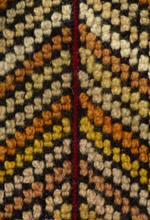Color Inside Out:
Art Meets Science through Natural Dyes
By Peggy Cox and Ann Throckmorton
Pokeberry, goldenrod, walnut, jewelweed, ironweed, joe-pye weed, willow, staghorn sumac, wingstem, and bidens. Fall in western Pennsylvania is nothing short of stunning, painting the fields with color and providing raw materials for natural dyes. Westminster College is located in New Wilmington, Pennsylvania, in the heart of Amish country. It is here that art and biology professors Peggy Cox and Dr. Ann Throckmorton team-teach a "cluster course" called Art and Nature. Cluster courses combine different disciplines to explore common themes from different vantage points, noting where subject matter, philosophy, and methodologies converge and diverge. In our cluster, we studied natural dyes in the fine art studio, finding and testing plants for colors and observing how different fibers respond to dyes. Biology labs focused on extracting plant pigments and determining how color is affected by chemical and physical changes in the dye bath. At the end of the semester, our 15 students displayed their art work and scientific results at a campus-wide exhibit and at a regional Student Symposium on the Environment.
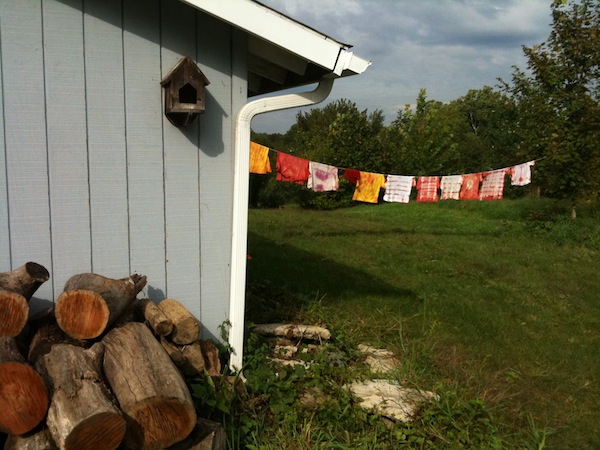
This all began about four years ago when we were considering how to merge art and science in the classroom, studio and lab. Dr. Throckmorton is Associate Director of the College's Field Station and teaches courses in ecology and field biology. Professor Cox teaches a variety of studio art courses and is an avid gardener. Perhaps it was our shared respect for nature that inspired the idea to investigate plant pigments. As a result, a small dye garden was started at the Field Station.
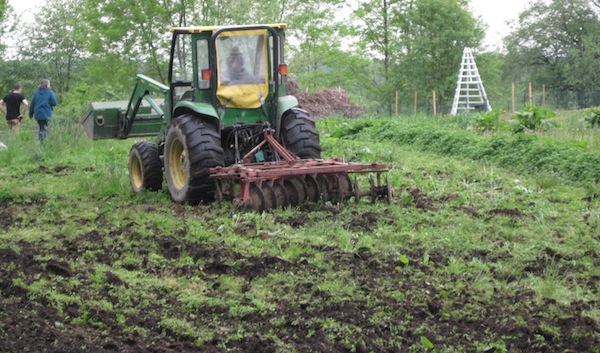
| Plants growing in the dye garden | Westminster College greenhouse |
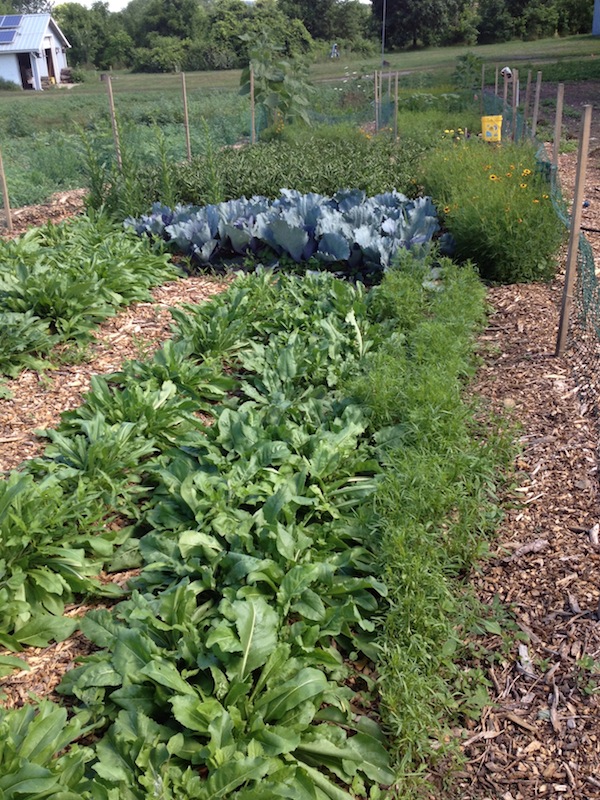 |
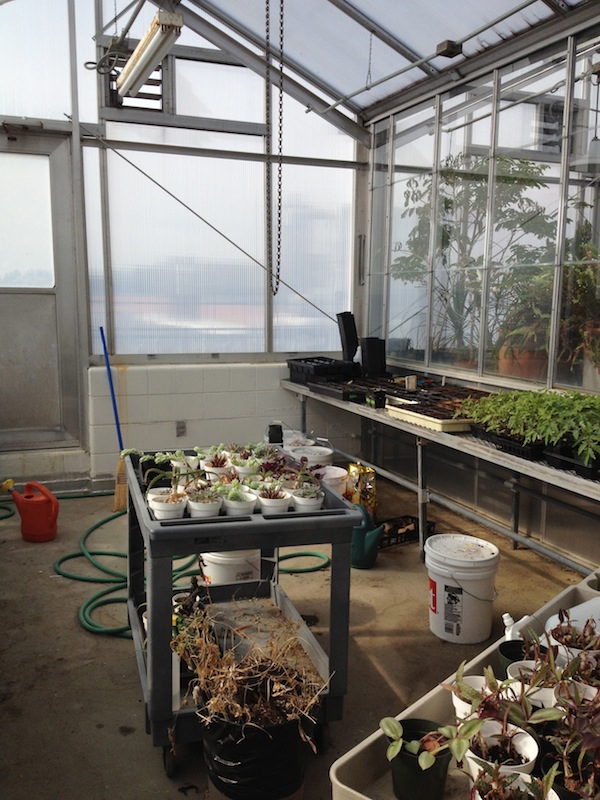 |
| Photograph Copyright by Peggy Cox and Ann Throckmorton | Photograph Copyright by Peggy Cox and Ann Throckmorton |
The dye garden expanded our palette beyond regional plants. Dr. Throckmorton manages the biology department's greenhouse and suggested we try starting indigo, weld, and madder from seed. But with a late start and short growing season, the plants were not going to be ready for fall classes. A few woad, weld and madder plants were purchased from a regional online nursery. Internet research led to Roland Ricketts of Indiana University (www.indigrowingblue.com) who gave us great advice on growing Japanese indigo (Polygonum tinctorium) and generously donated indigo cuttings to jumpstart our garden. Today, the dye garden has expanded, a new fine art course was developed around natural dye, and our cluster continues to be popular with students.
Studio Art Projects–Peggy Cox, Professor of Art
I was a dyed-in-the-wool (pun intended) landscape painter unfamiliar with dyes or textile arts, so I spent the summer locating books, Internet resources, and local artists to help out. The Internet search led to a workshop in eco-bundles with India Flint. At the workshop, Flint suggested I read Wild Color by Jenny Dean and another workshop participant suggested the book Harvesting Color by Rebecca Burgess. Two dye suppliers, Earthhues and Maiwa, were very generous with advice about setting up a bare bones dye studio and instructions for mordents and dye techniques. The summer was spent practicing and testing plants. I experimented with different mordant methods. I also made indigo from fresh woad and Polygonum tinctorium leaves. The experience of being a total novice provided insights into what students would go through in our cluster or any course with labs. My novice status actually was also helpful in designing projects that were less complex and time consuming. Students relaxed and learned that in art and science, investigation requires courage; that failures and successes are equally valuable experiences. Letting students know I was in new territory also provided them insights into how professors do research, continue to expand skills, and seek help when needed. In my case, it meant having several guest artists come to campus.
Author and artist Rebecca Burgess was a guest artist on campus for two days. To prepare for Burgess's visit, Dr. Throckmorton and I relocated our hotplates and dye pots to a shed at the Field Station, close to the dye garden. We also set up a lab in the Nature Center for demonstrations and hands-on work with fabrics, dyes, and mordants. Burgess introduced new colors that I had not tried yet. She and our students set up madder root and Coreopsis tinctoria dye baths with flowers from her own garden. In her book, Burgess had a recipe for pokeberry red and the students prepared the dye bath under her direction. For those of you who aren't familiar with pokeberry, it is an invasive shrub that provides a stunning red comparable to that of cochineal. The downside is it isn't as lightfast, requires massive amounts, and makes quite a mess. Our class had collected over 35 pounds of the berries that were frozen and stored in two of my neighbor's freezers and in the biology department freezer. This dye bath requires a 25:1 ratio (25 pounds of berries dyes 1 pound of fiber) and requires a special vinegar mordant. Students fell in love with the color. Burgess also introduced our students to organic indigo and painting with dyes and mordents. Perhaps the most fascinating aspect of her visit was learning about her fiber shed project and the "150 Mile Wardrobe" (www.youtube.com/watch?v=rEJmXmTFpMg).
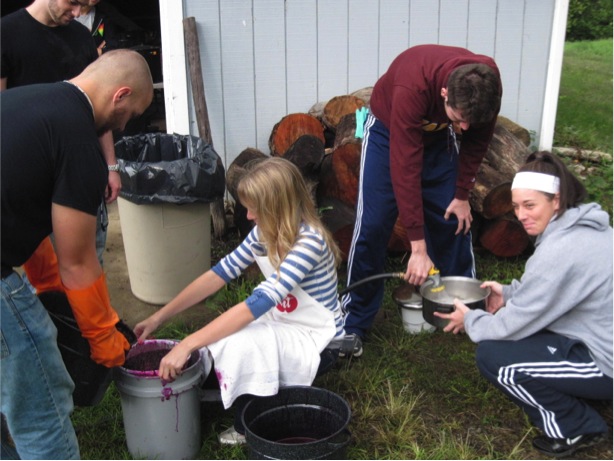
| Rebecca Burgess inspects the dyes | Rebecca Burgess and dye painting |
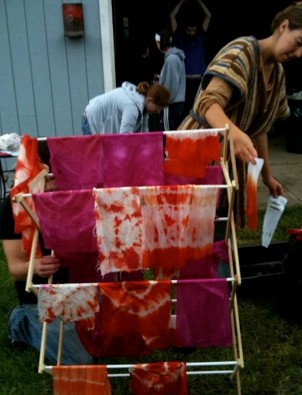 |
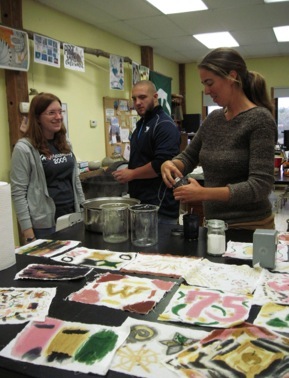 |
| Photograph Copyright by Peggy Cox and Ann Throckmorton | Photograph Copyright by Peggy Cox and Ann Throckmorton |
Students in this art/biology cluster were primarily non-majors and that means for studio art, I had to include instruction in design basics along with the new medium. Art projects needed to be both technically and conceptually accessible to students with a variety of skill levels. Students made eco-bundles and immersion dyes on various types of fibers. With those swatches, they were to create rough collaged wall hangings. Eco-bundles are fun, can be simple or complex, and the resulting prints are unpredictable. Students were introduced to some of the plants I previously tested. Then they had to locate, identify and harvest leaves. Plants included leaves of joepye, wingstem, sumac, walnut, ironweed, aspen, and Japanese maple. Students were also responsible for testing five plants not used in class. Throughout the course, notebooks were kept to document their results with eco-bundles and sketching the plants. Other projects included simple weaving on cardboard looms and shibori taught in mini workshops by local weaver Connie Davis and fiber artist Mary Lou Alexander (www.maryloualexander.com).
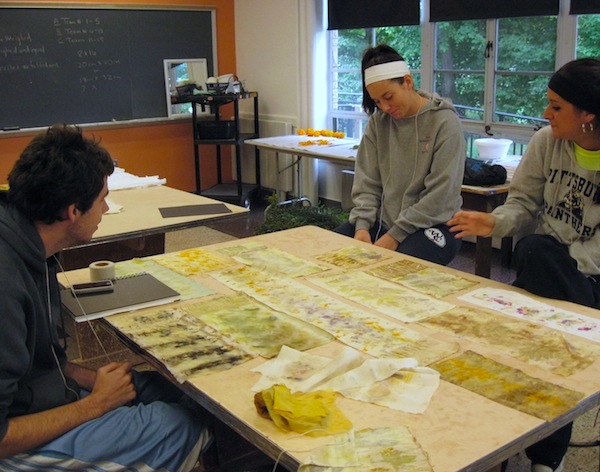
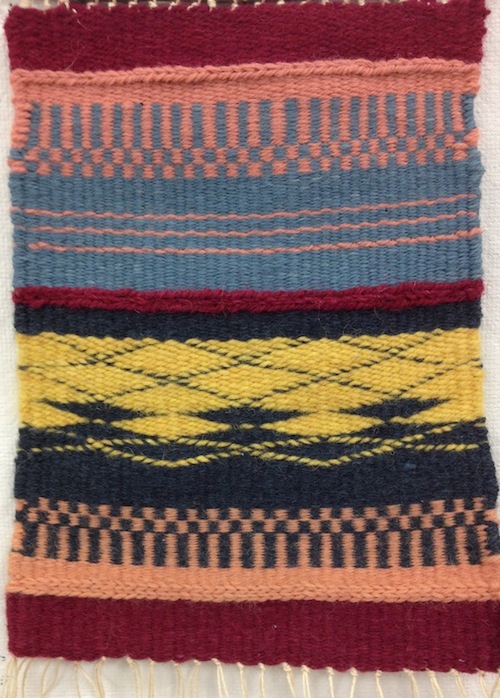
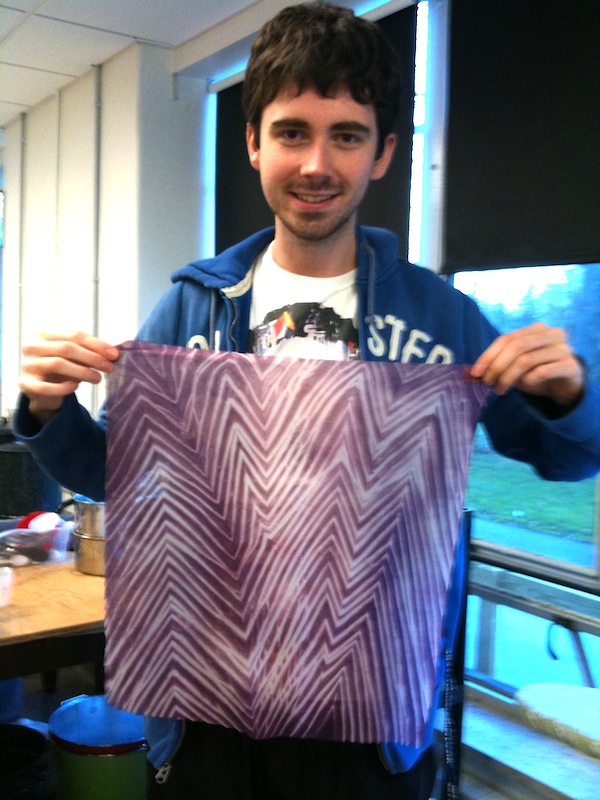
Simultaneously learning and teaching a new studio method is fun but rough. Add team teaching and the experience becomes a fluid, changeable, fly-by-the-seat-of-your-pants kind of experience. From the perspective of an artist, pairing a natural dye course with biology provides a strong underpinning of science that explains "why" plant pigments work the way they do, when mordants are needed, and what factors affect the colors that are obtained when using natural dyes. Learning how it all works from the perspective of science was fascinating, and students gained a breadth of knowledge that they would not have had otherwise. As subsequent art courses in natural dyes have evolved my dyeing, weaving, felting, and sewing skills also improved, but I still rely upon the science of it for a solid understanding of dyes.
Science Projects–Dr. Ann Throckmorton, Professor of Biology
In the biology classroom, students learned about the major types of plant pigments: chlorophylls, carotenoids, and flavonoids. They also learned of the primary functions of pigments in capturing light for photosynthesis, protecting plants from UV light and creating colors to attract pollinators and fruit dispersers. But the students didn't become truly interested in pigments until they saw them in the lab. We did a simple exercise in which juices from ground-up leaves were applied to strips of porous paper that were then placed in a small amount of solvent. As the solvent traveled up the paper, it carried the juice with it, separating the different pigments and making them visible. The students were surprised to learn that the color of a green leaf actually comes from four pigments, including two yellow carotenoids that are masked by the green color produced by two types of chlorophyll.
The most important part of the biology course took place in the laboratory, where the students did experiments with natural dyes. Many of them were dismayed to find that they needed to learn some basic chemistry to really understand what happens during the dye process. The students learned about protons and electrons and the chemical bonds that form as mordants help dyes adhere to fabric. I also talked about pH and why changing the pH with chemical modifiers such as vinegar, citric acid, ammonia, and soda will change the color that's produced. The students also learned about what happens when indigo is used to dye fiber. It involves a chemical process in which the movement of electrons converts indigo (which is not soluble in water) into "white indigo" (which is water-soluble). In the dye bath, the indigo is in its white form. When the cloth is exposed to air, the oxygen causes a chemical change that turns the indigo blue and makes it insoluble so that it adheres to the cloth. Because the students learned about the chemical reactions that occur during dyeing, they had a better appreciation of what they saw when they worked with indigo in the art studio.
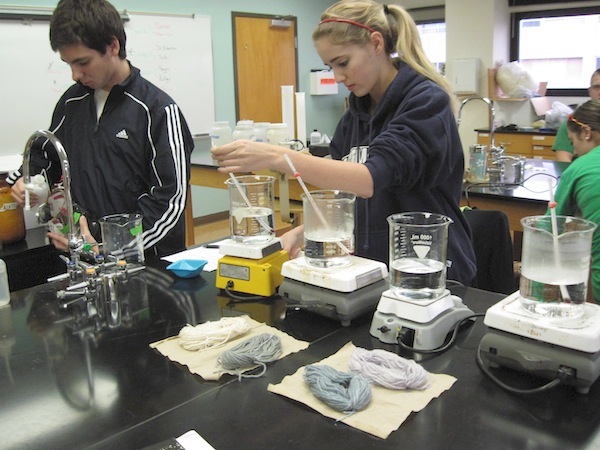
Once the students had learned about pigments and chemistry, it was time to apply their knowledge. They spent half the semester designing and performing experiments to determine what factors affect the color produced by natural dyes. Each group got to choose a dye. Not surprisingly, they selected ones that produce the most vivid colors: cochineal, logwood, madder, and indigo. They also had to choose two factors for experiments. Many of the groups looked at the effect of different mordants. Others altered the pH or the temperature of the dye bath. One group used different concentrations of their dye and another group used different water sources. Each factor had multiple levels. The experiments had to utilize the two factors simultaneously so the students could see how the two factors interact under many different conditions. With multiple factors interacting, the experiments were complicated!
Because most of the students in the class were not science majors and had never formally used the scientific method, the experiments presented quite a challenge. To help them organize, they had to turn in a detailed experimental plan that explained exactly what they were going to do, when they were going to do it, and what equipment and supplies they would need. Just developing the plan took several weeks. Performing the experiments and analyzing the data took another month. Then it was time for the students to learn about how scientists share the results of their research. We chose to have the students present their results through scientific posters to describe their work and their conclusions using text, tables, graphs, and images. When posters are displayed at scientific meetings, the researchers stand nearby to answer questions and discuss their research.
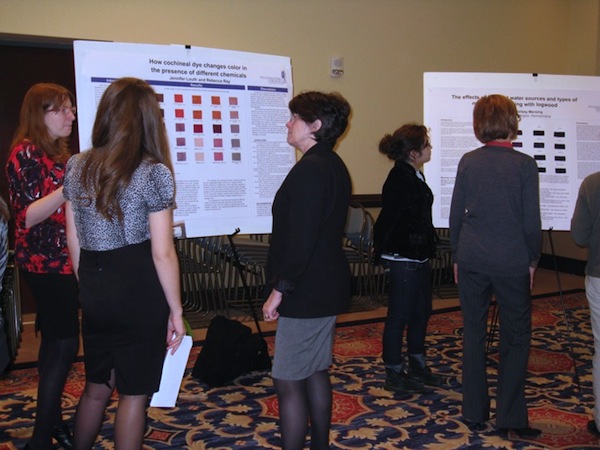
What Happens When Art Meets Science
The culminating experience of the semester was a combined art-science exhibition and presentation to showcase everything the students had accomplished. On one side of the room, tables and easels displayed the students' projects. The posters were on the other side of the room, with the students ready to discuss their experiments. Everyone on campus was invited, along with friends and relatives of the students. We were amazed at how many people came by and how enthusiastic they were about our students' work. In turn, the students were excited and proud to show off their accomplishments. It was truly a celebration of what can happen when artists and scientists cross disciplinary boundaries, to look at their own fields from a different point of view, and to make new discoveries.
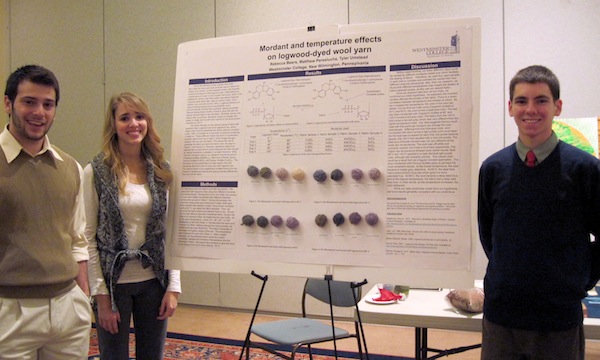
Students in our cluster course, Art and Nature, explored natural dyes using artistic practices and scientific methods. In the process, they learned to appreciate interdisciplinary collaboration and to recognize that all disciplines have their own strengths and limitations. By pairing courses in art and science, we were able to show that although there are fundamental differences between the fields, they are similar in many important ways. Although the products of science and art are very different, the methods used by both fields begin in the same way. Scientists and artists all rely on careful, detailed observations of the world. Those observations lead to the formulation of questions that the two fields then attempt to answer using their own methodologies. In this way, two disparate disciplines work together to give insight into the patterns of nature around us and the processes that produce them.
Acknowledgements
Partial funding for our course was provided by the Westminster College Drinko Center for Experiential Learning and by the Westminster College Environmental Speaker's Series. Special thanks to Rebecca Burgess, the Westminster College Field Station, Roland Ricketts, Mary Lou Alexander, and Connie Davis.
 Turkey Red Journal
Turkey Red Journal
